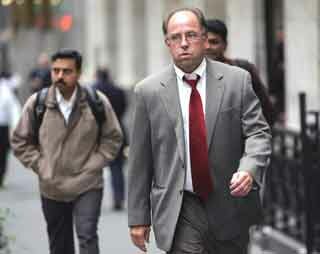How do you put together a consumer economy that works when the consumers are out of work? One of the great stories you’ll be hearing over the next couple of years will be about the large number of Americans who were forced out of work in this recession and remained unable to find gainful employment after the recession ended. We’re basically in denial about this.
There are now more than five unemployed workers for every job opening in the United States. The ranks of the poor are growing, welfare rolls are rising and young American men on a broad front are falling into an abyss of joblessness.
Some months ago, the Obama administration and various mainstream economists forecast a peak unemployment rate of roughly 8 percent this year. It has already reached 9.4 percent, and most analysts now expect it to hit 10 percent or higher. Economists are currently spreading the word that the recession may end sometime this year, but the unemployment rate will continue to climb. That’s not a recovery. That’s mumbo jumbo.
Why this rampant joblessness is not viewed as a crisis and approached with the sense of urgency and commitment that a crisis warrants, is beyond me. The Obama administration has committed a great deal of money to keep the economy from collapsing entirely, but that is not enough to cope with the scope of the jobless crisis.
There were roughly seven million people officially counted as unemployed in November 2007, a month before the recession began. Now there are about 14 million.
If you add to these unemployed individuals those who are working part time but would like to work full time, and those who want jobs but have become discouraged and stopped looking, you get an underutilization rate that is truly alarming.
“By May 2009,” according to the Center for Labor Market Studies at Northeastern University in Boston, “the total number of underutilized workers had increased dramatically from 15.63 million to 29.37 million — a rise of 13.7 million, or 88 percent. Nearly 30 million working-age individuals were underutilized in May 2009, the largest number in our nation’s history. The overall labor underutilization rate in May 2009 had risen to 18.2 percent, its highest value in 26 years.”
If it were true that the recession is approaching its end and that these startlingly high numbers were about to begin a steady and substantial decline, there would be much less reason for alarm. But while there is evidence the recession is easing, hardly anyone believes a big-time employment turnaround is in the offing.
Three-quarters of the workers let go over the past year were permanently displaced, as opposed to temporarily laid off. They won’t be going back to their jobs when economic conditions improve. And many of those who were permanently displaced were in fields like construction and manufacturing in which the odds of finding work, even after a recovery takes hold, are not good.
Another startling aspect of this economic downturn is the toll it has taken on men, especially young men. Men accounted for nearly 80 percent of the loss in employment in this recession. As the labor market center reported, “The unemployment rate for males in April 2009 was 10 percent, versus only 7.2 percent for women, the largest absolute and relative gender gap in unemployment rates in the post-World War II period.”
Workers under 30 have sustained nearly half the net job losses since November 2007. This is not a recipe for a strong economic recovery once the recession officially ends, or for a healthy society. Young males, especially, are being clobbered at an age when, typically, they would be thinking about getting married, setting up new households and starting families. Moreover, work habits and experience developed in one’s 20s often establish the foundation for decades of employment and earnings.
We’ve seen what happens when you rely on debt and inflated assets to keep the economy afloat. The economy can’t be re-established on a sound basis without aggressive efforts to put people back to work in jobs with decent wages. We also need to consider the suffering that is being endured by these high levels of joblessness, including the profound negative effect on the families of the unemployed. Lawrence Mishel, president of the Economic Policy Institute, warned about the consequences for children. “What does it mean,” he asked, “when kids are under stress because there is no money in the household, or people have to move more, or are combining households, or lose their health insurance? I believe this is going to leave a permanent scar on a generation of kids.”
The first step in dealing with a crisis is to recognize that it exists. This is not a problem that will evaporate when the gross domestic product finally begins to creep into positive territory.
Source: Bob Herbert (New York Times)


